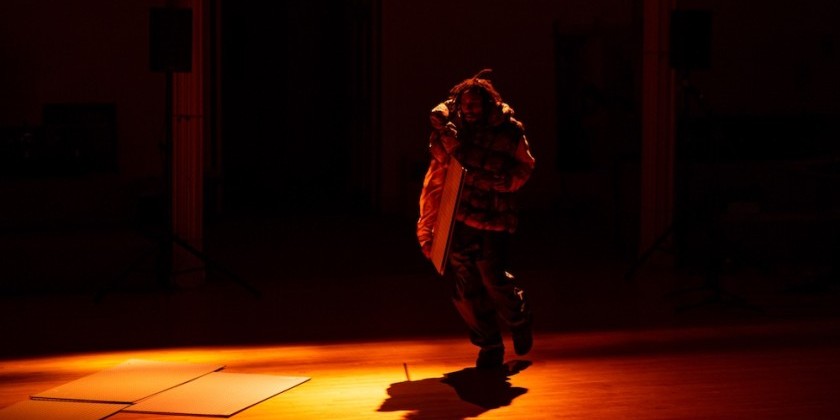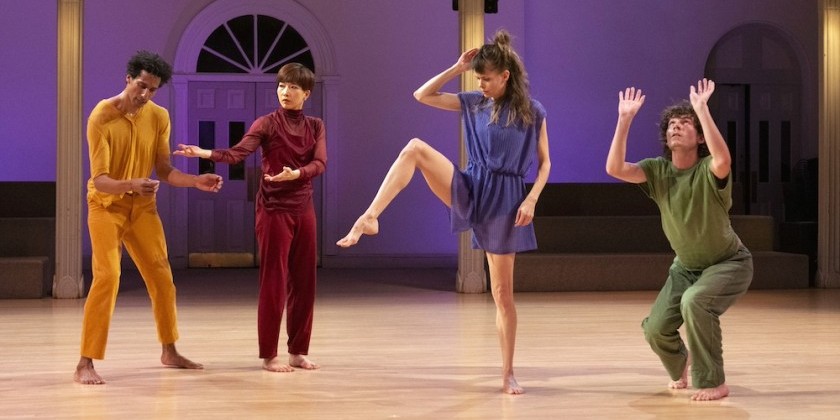Impressions of: Volmir Cordeiro in “INÊS”

Yearning for a Taste of Glory
November 6-7, 2015 at the Danspace Project, St. Mark’s Church-in-the-Bowery
Choreography and Performance: Volmir Cordeiro
Lighting Design: Beto de Faria / Sound Design: Cristián Sotomayor
Costume: Volmir Cordeiro/Sylvie Seguin / Manager: Margot Videcoq
Artistic Collaboration: Anne Lise Le Gac, Pauline Simon, Pauline Le Boulba
Translation: Vanina Géré
How delicious! (“Qué delícia!”) Scampering on stiletto heels, bending over to twerk and flashing a “V for victory” sign, Inês Brasil entreats the producers of the reality show “Big Brother Brasil” to pick up the phone and call her. She reminds them this is the fifth time she has submitted an audition CD. Although they never responded to the previous CDs, she harbors no ill feeling. Sprawling on the floor, the would-be contestant squeals as she imagines diving into the swimming pool on the “Big Brother” set.
For reasons that include an eye-popping pair of silicone breast implants, this audition recording goes viral when it is posted to YouTube in 2013. “Big Brother” never calls. But Brasil doesn’t need them anymore. She becomes an Internet sensation with millions of followers, and soon the networks are offering her spots on talk shows, cooking shows and even a Christmas special.

Watching these fire-works from a distance, another Brazilian performer, Volmir Cordeiro, becomes obsessed with them. He has a master’s degree from the prestigious Centre National de Danse Contemporaine d’Angers, in France, and is working toward a Phd., but it seems likely that his thesis on “marginality in contemporary dance” will never receive the attention that Brasil attracts casually by lifting her hair to cool her neck and panting. Within a year, Cordeiro has choreographed a solo for himself that he titles Inês, in which he reflects on the terrible price of celebrity and the pitiful and degrading stunts to which those who yearn for fame must lower themselves. Applying his knowledge of performance theory, Cordeiro also thinks hard about the way audiences and performers devour each other with an anthropophagous gaze. His solo Inês receives its US premiere on November 6, at the Danspace Project.
The solo begins with a blast of sound—raucous Carnival music with a thumping beat punctuated by gun-shots and indistinct background noises that suggest someone has left the television on. When the lights come up, Cordeiro is slouching by the entrance wearing a preposterous costume that consists of skeins of colored fabric wrapped around his torso. He looks like a ball of rags with skinny legs and arms sticking out bare.
Sashaying down the center of the floor, Cordeiro takes a position close—uncomfortably close—to the spectators seated on cushions in the front row. Pressing up against this audience, his stance is loose and gangly but assertive. He explains loudly that Inês is a woman “wrapped in melodies” that are “very, very, very hot.” Her ambition is to become “part of the great show we call reality.” Losing himself in a string of repetitive syllables, Cordeiro urges us to look at her. “Go, go, go, c’mon, go look at her, guys.”

Moving to the center of the space, Cordeiro lolls on the floor and rests on his elbow. He unwinds a sheet, disentangling it from the fabric in his costume, and puts himself to bed. His monologue starts to sound wooly, and he reverts to Portuguese. Later he rises and declares his love for all of us—“everyone here.” Crashing to the ground, he exclaims, “Wow!” as if in response to his declaration of love we have just ravished him and he enjoyed it.
Unexpectedly, quietly, this brassy but defenseless man begins to cry. He removes a roll of tape from the folds of his costume, and uses pieces of tape to black-out his eyes. A “blind” section follows in which he staggers, pretends to bump into a pillar, and crosses the floor on a diagonal clearing the space ahead with broad, swimming strokes. From shouting he passes to whispers, mumbling something behind his hand. He leaps and slaps his butt. In Inês, Cordeiro uses every strategy he can think of to connect with the audience—to seduce, to dominate, to amuse, to beguile. Near the end he spars with us, shadow-boxing, but he also bows deferentially. He appropriates Brasil’s “victory” gesture, though as in her audition recording declaring victory seems premature.
Taking pot shots at reality television and sneering at tabloid idols is a no-brainer. Whatever we may think of Inês Brasil and her bazooms, however, can anyone who sets foot on stage honestly fault another performer for exhibitionism and a desire to taste glory? As Inês might say, “Always brothers, always united.” (“Sempre irmãos, sempre unidos.”)
Share Your Audience Review. Your Words Are Valuable to Dance.
Are you going to see this show, or have you seen it? Share "your" review here on The Dance Enthusiast. Your words are valuable. They help artists, educate audiences, and support the dance field in general. There is no need to be a professional critic. Just click through to our Audience Review Section and you will have the option to write free-form, or answer our helpful Enthusiast Review Questionnaire, or if you feel creative, even write a haiku review. So join the conversation.













